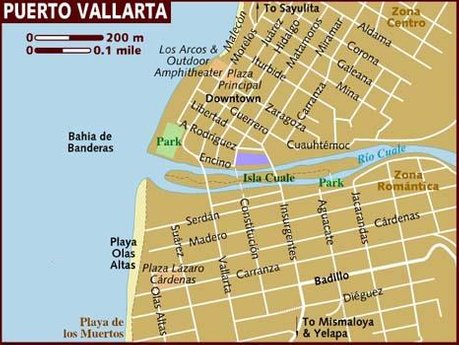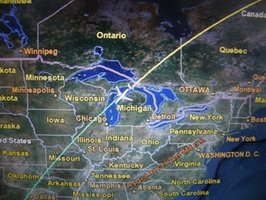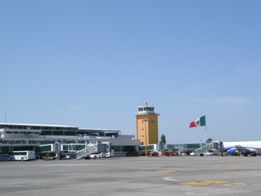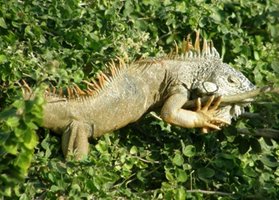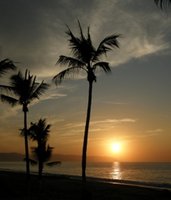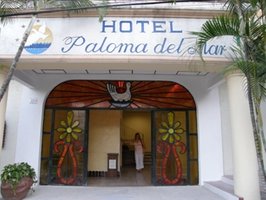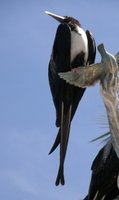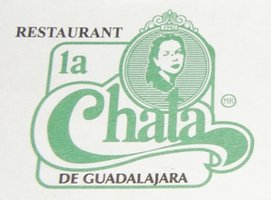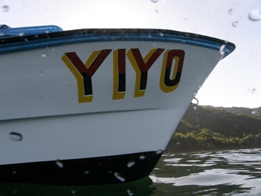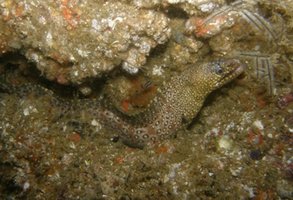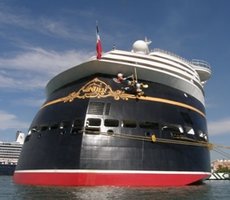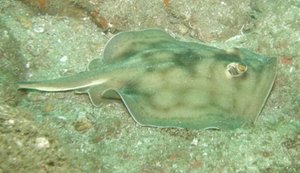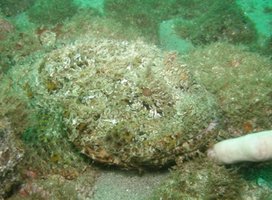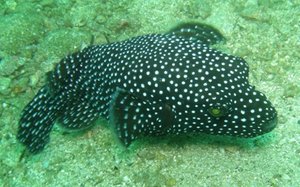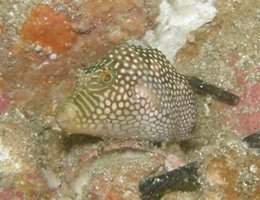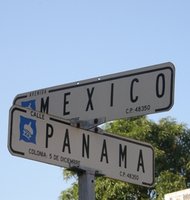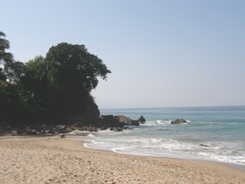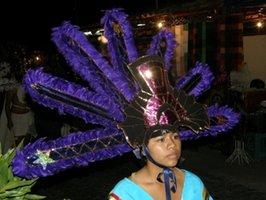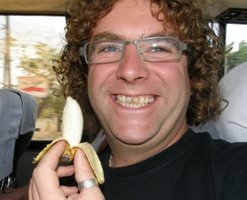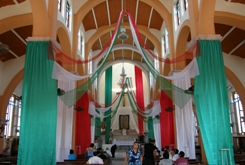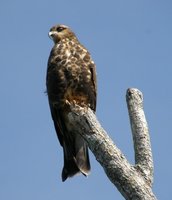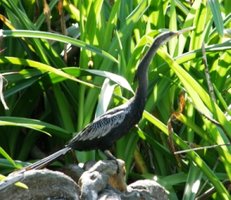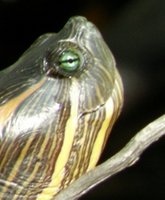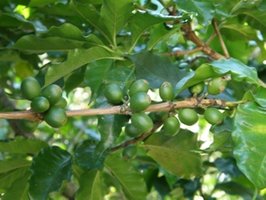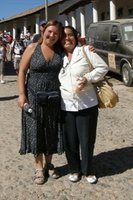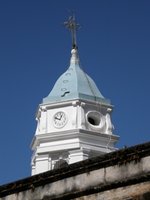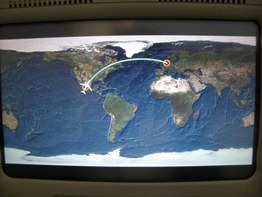ScubaTimo
Pagina over duiken en reizen in binnen- en buitenland
Website about scuba diving and traveling around the globe
Mexico Puerto Vallarta in Hotel Paloma Del Mar
Scuba Diving with Banderas Scuba Republic
From Monday November 28th to Thursday December 6th, 2011
Mexico
The United Mexican States (Spanish: Estados Unidos Mexicanos), commonly known as Mexico is a federal constitutional republic in North America. It is bordered on the north by the United States; on the south and west by the Pacific Ocean; on the southeast by Guatemala, Belize, and the Caribbean Sea; and on the east by the Gulf of Mexico. Covering almost two million square kilometres (over 760,000 sq mi), Mexico is the fifth largest country in the Americas by total area and the thirteenth largest independent nation in the world. With an estimated population of over 112 million, it is the eleventh most populous country and the most populous Spanish-speaking country. Mexico is a federation comprising thirty-one states and a Federal District, the capital city.
In Pre-Columbian Mesoamerica many cultures matured into advanced civilizations such as the Olmec, the Toltec, the Teotihuacan, the Zapotec, the Maya and the Aztec before the first contact with Europeans. In 1521, Spain conquered and colonized the territory from its base in México-Tenochtitlan, which was administered as the Viceroyalty of New Spain. This territory would eventually become Mexico as the colony's independence was recognized in 1821. The post-independence period was characterized by economic instability, the Mexican-American War and territorial cession to the United States, a civil war, two empires and a domestic dictatorship. The latter led to the Mexican Revolution in 1910, which culminated with the promulgation of the 1917 Constitution and the emergence of the country's current political system. Elections held in July 2000 marked the first time that an opposition party won the presidency from the Institutional Revolutionary Party.
Mexico has one of the world's largest economies, and is considered both a regional power and middle power. In addition, Mexico was the first Latin American member of the Organisation for Economic Co-operation and Development OECD (since 1994), and a firmly established upper-middle income country. Mexico is considered a newly industrialized country and an emerging power. It has the thirteenth largest nominal GDP and the eleventh largest by purchasing power parity. The economy is strongly linked to those of its North American Free Trade Agreement (NAFTA) partners, especially the United States. Mexico ranks fifth in the world and first in the Americas by number of UNESCO World Heritage Sites with 31, and in 2007 was the tenth most visited country in the world with 21.4 million international arrivals per year.
Puerto Vallarta is a Mexican balneario resort city situated on the Pacific Ocean's Bahía de Banderas. The 2010 census reported Puerto Vallarta's population as 255,725 making it the sixth-largest city in the state of Jalisco. The City of Puerto Vallarta is the government seat of the Municipality of Puerto Vallarta which comprises the city as well as population centers outside of the city extending from Boca de Tomatlán to the Nayarit border (the Ameca River).
The city is located at 20°40′N 105°16′W / 20.667°N 105.267°W / 20.667; -105.267. The municipality has an area of 502.19 square miles (1,300.7 km2). To the North it borders the SW part of the state of Nayarit. To the east it borders the municipality of Mascota and San Sebastián del Oeste, and to the South it borders the municipalities of Talpa de Allende and Cabo Corriente.
Puerto Vallarta is named after Ignacio Vallarta, a former governor of Jalisco. In Spanish, Puerto Vallarta is often shortened to "Vallarta", while English speakers call the city P.V. for short. The city occasionally is spelled or pronounced as Porto Vallarta. In internet shorthand the city is often referred to as PVR, after the International Air Transport Association airport code for its Gustavo Diaz Ordaz international airport.
Climate
Puerto Vallarta's climate is typical Tropical wet and dry (Köppen climate classification Aw), with a marked dry season in the winter. The high temperature and variations in humidity can make July through September nearly intolerable. It has pronounced wet and dry seasonal variation, with sudden monsoon-like rains from July through September, normally for a few hours in the evenings.
The average daily high temperature is 86 °F (30 °C); average daily low temperature is 70 °F (21 °C); average daily humidity is 75%. The rainy season extends from mid June through mid October, with most of the rain between July and September. August is the city's wettest month, with an average of 14 days with significant precipitation. Even during the rainy season precipitation tends to be concentrated in large rainstorms. Occasional tropical storms will bring thunderstorms to the city in November, though the month is typically dry. February, March and April are the months with the least cloud cover.
Prevailing winds are from the southwest, and most weather systems approaching Puerto Vallarta are consequently weakened as they pass over Cabo Corriente. Thus even during the rainy season Puerto Vallarta's weather tends to be mild compared to other areas along the Mexican Pacific coast.
Hurricanes seldom strike Puerto Vallarta. In 2002, Hurricane Kenna, a category 5 hurricane, made landfall about 100 miles (160 km) northwest of Puerto Vallarta, and the city suffered some damage from the resulting storm surge. In 1971, Hurricane Lily, a category 1 hurricane, caused serious flooding on the Isla Cuale, prompting the city to relocate all of its residents to the new Colonia Palo Seco.
Monday November 28th, 2011: Departure to Puerto Vallarta, Mexico
It is dark, the alarm wakes us up at two AM and Timo is getting out of bed, Veerle is already up and is watching her favorite show ‘Thuis’ that was recorded the previous days on the Digicorder. Timo comes downstairs and then both of us start action. On this wicked hour of the day we take a shower, prepare everything to leave. On Saturday we had a hectic day still: Veerle still had to work and Timo had to go to the vet with Cartouche, because he had an inflamed paw. He gets pills and the paw needs to be protected so he can’t lick it. Then the house needed to be cleaned and n the evening we had family dinner. That was very nice. We were up until half past one so it was a pretty busy day in the end. On Sunday we mostly wanted to rest and pack. Timo already did the hand luggage the day before, so we only needed to pack the big luggage and a smaller bag. After taking a shower we’re completely ready to leave. We quickly check the hours of our flight, but all seems OK, so we get in the car and leave for SchipholAirport at two thirty. There is not a person on the road and everything goes fast: in less than two hours we’re there and get access to the Long Term parking with the credit card we used for the reservation and then start looking for a free spot. We find that in row 303, not too far, so very nice. We walk to the main building with all of our bags and there is a pickup with a shuttle bus to the departure hall.
Every ten minutes a bus stops here and drives people to the departure hall with two stops. We get off at the second one: that was already indicated on the website of Schiphol, nice and easy. We go to the check-in and this time we’ve chosen Comfort Class: for such a long flight it provides some extra leg-room and a couple of other extras. We don’t need to queue and after five minutes we’re done. Because we’re not completely sure whether the car has been locked, we return a moment to the parking with a shuttle bus. When we get there the car is locked – of course what did you think? Se we return to the departure hall, smoke another cigarette and then walk to gate D02 for boarding. It is already a bit later, because we lost forty five minutes going to and returning from the parking. Well, you can hardly call the time lost, because we now don’t need to find a place and sit down for that period of time. We should commence boarding at six thirty and that is indeed the case. We first need to pass a metal detector and then wait another fifteen minutes to actually board the aircraft. Everything goes well, because here at Schiphol each gate has its own metal detector and that ensures good timing. We take our seats (8E and 8F) and here we’ll be stuck for the next fourteen hours.
After half an hour everybody is on board and we have settled in quite well already, we have hope of window seats for a few moments, but these seats are taken in the end. At seven thirty sharp we’re ready to leave and the pilot starts the engines of the aircraft. It’s nice to leave right on time, because Timo’s experience with Arke was not so good previous time. It goes better this time and the pilot announces we won’t fly fourteen hours, but only twelve and fifteen minutes. In the end that will be fine. The first tour of the crew is to activate the in-flight-entertainment, because it’s not active, not even in Comfort Class. The next time they pass is to offer a drink and we have a coffee and some water. Everything is OK, although we’re not really happy with this upgrade. If you reserve and pay for a more expensive seat, then you would expect a bit more than just extended legroom. We leave for vacation, so we’re happy already. We stay seated and rest a while and after about an hour they provide another drink, now we need to pay. Veerle has the entertainment activated and now we can watch a movie for a while. Timo also watches the screen of Veerle and he can hear the sound by using the same plugs as Veerle. It takes a while before we get something to eat and that is also something we need to take into account when we return. Veerle asks for a blanket, because it’s cold, but they’ve run out already: that is not so positive for Arke on such a long flight. We have pasta when they offer us food and then watch a movie: Larry Crowne. Nice, but nothing more to say about it. Timo seems to be a bit tired and closes his eyes for an hour: better than nothing.
In this way the flight continues. We left Schiphol, then flew over Scotland, then continued over Iceland and then headed towards the Canadian coast. Over Canada we fly to the US border and then to the south. We cross Chicago, Illinois and Peoria, the home of Timo’s employer. Over the states of Missouri, Oklahoma and Texas. From the border with Mexico it’s only a couple of hours more and until now everything was OK. We only had a couple of moments turbulence and not that bad anyway. And then suddenly everything moves very fast. We see the sea and that means we arrived at the west coast of Mexico. The pilot will fly over the sea, over the Bay of Banderas and then reach the landing strip. We touch down, get on a bus and need to pass through customs. No hour-long queues, already after ten minutes we’re through. We already received two documents to fill out, the stamps are printed in the report and then we can collect our luggage. We quickly exchange currency: it’s good we already have Mexican Pesos, you never know what happens. We need to wait for our luggage and then pass the check for the full luggage control: everything needs to go through a scanner and then we can go out. There is a small stop at the tourist information, because we can’t avoid them – they already try to sell us tours now, but our mind is not set to it: first we want to go out for the Mexican sun and a cigarette. About ten people of Arke are waiting outside to direct us to the correct bus. We have to take bus number five and we need to wait on the transfer to our hotel; PalomaDel Mar. first we need to change to another bus, because the first one has engine problems. Then after about an hour we’re ready to leave. It’s only a half hour drive and that’s nice. We arrive immediately in the center and it’s very busy traffic. We receive some general information about the way Mexicans drive and then we arrive in the small ‘calles’ in downtown Puerto Vallarta. She advised against a rental car, because the only people with a valid driver’s license are taxi- and bus drivers. OK, something to think about.
And then we finally arrive: the hotel, check in and go to room 113. The room is small, a bit old, but typico Mexico and it’s clean. We start the fridge and take a shower and then go out to explore the city. It’s still early and we need to pass a whole day, because it’s best to adapt to the time zone immediately to minimize the jetlag. After the shower we step into the Mexican world of Puerto Vallarta, but first we stop to buy water and soft drinks and take it back to the hotel to cool it in the fridge. And then we really leave. The hotel is on the Calle Honduras. All names of streets here have been derived from South and Central American countries. The streets are paved with cobblestones and they cause an unbearable noise when cars, buses or trucks pass by. It’s not really clean, because waste water runs over the streets everywhere and that spreads a bad scent. Add to that the more pleasant odor of the food stalls and then mix it all with the smell of diesel, you end up with an unpleasant mixture, but it’s typical. We walk to the sea and after only five minutes we can let our hair blow in the wind and smell the salinity of the ocean: this smells like vacation. We continue our stroll on the beach and spot frigatebirds and pelicans. This makes Timo’s day. After ten minutes we reach the Malecon: this is a boulevard next to the sea that takes us to the old city center. We continue, have a break at a nice market place and have an ice-cream (Veerle that is) and then move on. We cross the Rio Cuale and arrive in the buzzing center. Suddenly Timo spots a huge iguana that is enjoying the sun. A couple of white herons are looking for food in the river and we also wee the common grackles. We don’t know the common Dutch word, but it’s a large bird, the size of a pigeon with a long black tail and they make a hell of a noise. At this moment we’re mainly focused on the iguana: it is a beautiful animal and a pretty large one too. You can clearly see the long toes on the paws and a beautiful long tail on the branch. Yes, our first iguana during this vacation.
We’re on the move already for quite a while and start to get thirsty. We sit down on a chair on the beach and already look forward to a nice holiday. At about six we start looking for a restaurant where we can eat and we start at the Malecon. The name of the restaurant today is tied to the name of our hotel: Las Palomas. There are plenty of pigeons here, so that’s normal. We order a cola and a strawberry daiquiri with a salad and two enchiladas: one chicken and one cheese enchilada. The drinks are good, the salad also and the tapas with it are also quite nice. At first we need to adapt to the Mexican spices. Everything is very spicy, but not killing the taste. The enchiladas are not so good, but we’re hungry so we like it anyway. It is way to much, we just wanted to eat something, but we ordered more than we could chew. In the end we only got one meal on the flight and we bought a sandwich to share, so not a lot really. At about seven we go back to the hotel through the small streets. There we clean our feet and then can go to bed. It’s still early, because it’s only a bit past eight, but we hope we can sleep to tomorrow morning.
Tuesday November 29th, 2011: Arrangements for excursions, diving and explore Puerto Vallarta
I jetlag, you jetlag, he jetlags and I have jetlagged. I is in this case Timo a little bit, because he’s already awake at four in the morning. Usually he has no problems with a jetlag, but this time he’s awake a bit too early. No problem, because there is enough to write about yesterday, so he sits down on the balcony and enjoys the peace of the night. It was a long day yesterday, because we were awake for twenty-four hours, so it is not surprising that he wakes up after eight hours of sleep. No idea what the rest of the day will be like. Timo finishes the report an hour later, lays down on the bed and at about seven we’re both awake and prepare ourselves to check out the hotel. There is no much to see, but we want to visit every floor to find out what is where. First we’re at the reception, because Veerle wants to put everything in the safe. Those are free of charge, so that’s nice. We only need to request a key at the reception and we get a second one and with those two keys we can open the safe. All our valuables are stored there: passports, tickets and the main part of our money. Then we go to the forth floor because there is the restaurant of the hotel. Normally it’s only open at eight, but we ask if we can already sit down and we can start our breakfast. That’s nice. In the offer of Arke we have continental breakfast, but that’s only a cup of coffee and two toasts each with some butter and marmalade. That’s not much, so we pay five USD extra for unlimited toast, coffee and eggs. We sit very high and have a great view on the city and the sea. We take a window seat to enjoy this view fully. There is a small Christmas tree on the table and that gives a nice atmosphere. Christmas mood at thirty degrees: special at least.
After breakfast we take it easy and want to check out the info session of the stewardess. We already planned for two days of diving, but for the rest nothing really. We first get some info using bank cards and also what we need to know about restaurants, buses, taxis and a load of other things. It’s not un-interesting. She speaks half an hour about the possibilities to take a tour and we’re interested in taking two. San Blas needs to be in there. If you then check out the price of the bus and the entry to do all this independently, it’s not even that expensive with Arke. We don’t really like to be in a herd of tourists, but we prefer the easiest and safest solution. To rent a car for example would be not-done here. We choose one tour that has nature and another one with culture. Timo wanted both and Veerle is OK with that: a good mix. Or Veerle just had nothing to say. We already pay and tomorrow the vouchers and all info will be at the reception. We then go to the dive shop, but nobody is in and there is a note for Timo. They’re out for diving and someone will be there this afternoon.
We still have some time for us. We walk through the center and always stay parallel to the sea, so at a certain point we need to take a right to reach the beach. We walk with our feet in the salty water and just follow the shore. The water is cool and does us well. We enjoy the walk and pass by a couple of nice bars. Here close to the water you’re not bothered by the salesmen; on the terraces that’s something else. And then suddenly Timo can’t believe his eyes. Something small of about forty centimeters swims towards us. First he thinks it’s a small sea turtle, but then he discovers it’s a small manta ray. That is so astonishing, unbelievable actually. He’s too late to take a picture, but we’re almost certain it’s a manta ray. A great spot. Neither of us would have thought that we would see something like this over here. We have walked already several miles and started early this morning. From the hotel to the diveshop it is about one hour walking, especially with all the detours we’ve made. Sow e think it’s about time to have a drink. We sit on the beach with our feet in the sand. Timo has a Corona and Veerle a normal coke. It is very nice relaxing in the shadow still having the warmth and there is a lot to see. The pelicans fly past and regularly dive into the water. Apparently they have a regular catch here. Also frigatebirds fly on and off, but we already saw some very close earlier today. On one of the monuments of the Malecon they were cherishing the sun and it almost seemed as if they were part of the statue. Now they’re in the sky and fly gracefully carried by the wind. We love these birds.
Veerle is hungry and orders a shrimp-cocktail. And a cocktail it is. On the bottom of the glass there are tomatoes, onion and herbs, above are large shrimps and avocado. Served with that we have some tortilla and we both taste it. We’re not used to have a shrimp-cocktail this way, but it’s good and very refreshing. They served quite some shrimps, over ten in total. If you imagine this scenery, you would think that this is a perfect place and it actually is. One small disadvantage is the salesmen constantly passing by. They sell massages, necklaces, hammocks, and tablecloth, name it; they have everything here, even tattoos. Apart from salesmen you also have the singers; mariachi’s who sell their voice. Every passing by salesperson receives a friendly no gracias, nada. Even a buenas dias if they want. If you’re here for a couple of hours it gets annoying, but we’re on vacation so it does not really matter. At about two o’clock we walk to the cathedral: it’s a nice building from the outside located in the small streets. At the inside we expected w bit more gold and paintings, but it’s not bad.
We then return to the diveshop BanderasScubaRepublic to make all arrangements for tomorrow. We first get some general information and then we try on the suits, the BCD, fins and arrange that Cesar comes to pick us up tomorrow at the Pemex gas station. We also need to fill out all normal PADI forms and everyone knows that you need to answer No everywhere. We have everything in order within the hour and then say goodbye to Cesar and we can look forward to diving tomorrow. Because she had some troubles when trying on the seven millimeter suits we start looking for panty’s for Veerle. We have found a supermarket and buy chips, bread, fruit, but we’re not able to find any panties. So we return to the hotel and keep our eyes open for a shop to buy them. And then Veerle finds what she needs close to the Señor Frog restaurant. Everybody is happy, so we get back to the hotel then. There we want to cool off at the swimming pool, but we don’t manage to actually have a swim. We only cool off our feet, because the water is way to cold. Just like the water in Banderas Bay according to Cesar – a cool twenty three degrees. We’re not so tired anymore and rest for about an hour in our bed. We also check out the pictures and the travel reports. At about six we’re already back downtown, looking for a restaurant and have dinner. We haven’t eaten a lot today, so we need to find something soon.
We go to the center and the Malecon. As always people ask us to buy something, to look at something or whatever. Already the second day this starts to annoy us. But we try not to be bothered and walk on and say no gracias. Whatever they ask us. It can sound strange when we answer the question Where are you from in that way. On the Malecon there are loads of restaurants and shop. Passing by a hamburger restaurant they want to invite us in, but we want to have Mexican food and no hamburgers. He advises us to go to the next corner and eat at La Chata. We check this out and decide to dine here. With our aperitif we get some salsa picante and beans. Everything in Mexico goes with beans in any form. We order a glass of white and red wine and spaghetti Bolognese and one La Chata shrimp. It is very good. In Belgium we would know this type of shrimps as diabolique, but here they’re being served a bit spicier. We have a table on the first floor and love the relaxation, the Mexican music, the food and the company. We’re having a good time. We have a great view, because we can see the sea, the waving palm trees and it is in one word: great! We order another wine and a coffee, not an espresso, but a big American coffee. The Mexican wine is not bad, but no need to say something else about it. We stay out longer than yesterday and return to the hotel at about nine. We stop at a square close to a large church to check on a small group of dancers. We stop and listen to the music and look at the dancing group and then go on to the hotel. We quickly use the wireless internet at the reception and then go to sleep. It has been a hot and tiring day, so we fall asleep pretty soon. Buenas noches and sleep tight!
Wednesday November 30th, 2011: First diving day at Los Arcos
I dive, you dive, we dive, one day the whole world will dive. Or maybe not. We start our day early: Veerle wakes up at about four, Timo one hour later; we return to our bed and get up at seven. Everything OK? Yep, sure. We ensure everything is ready for our first dives here: masks, camera, towels and all other stuff you usually take with you for diving. Then we go up to the restaurant for breakfast. If you take the extra, the breakfast is nice: scrambled eggs, toast, coffee and juice, the same as yesterday. Because we’re so early, we have the same table as yesterday with a great view on the city, the sea; it’s really nice from the forth floor. We have our breakfast and then it’s time to head for the Pemex, the gas station close to the hotel, because there Cesar will pick us up to bring us to the harbor and there we leave for diving. When we get there he’s already waiting for us, well arranged, on time, even a few minutes early. He waits for us in a white pickup with the logo of the BanderasScubaRepublic and a white and red DAN-logo. He greets us very friendly, like we’re already friends for years. We already expected that yesterday when we first met him, that the service would be very personal. We leave immediately, because taxi-drivers should not see him picking us up. He would be in trouble then. The taxi drivers are some kind of mafia. White taxis take people back to their hotels, the yellow ones from the hotel, but everything is not so clear. We haven’t seen a single white one and the drivers of the yellow taxis constantly ask if you need a ride. In short, if Cesar would pick us up at the hotel, a taxi probably would block his way, because they would feel that he’s stealing their business and they don’t like that.
We head on with Cesar to pick up two more people: Chris and Al. They are in Nuevo Vallarta and that is on the way to the tank filling station that Cesar uses here. On our way there we get some information about the history of BanderasBay, when the Spanish conquistador arrived here and he only saw flags (Banderas) on the beach. Cesar also confirms the story of the stewardess that most people don’t have a driver’s license and it’s not safe to drive. Then again, Cesar is Spanish and he drives here too, so???? In one of the small streets we stop and load the tanks: ten in total. And then we go to the harbor. We see a pier with a dozen of boats moored and we help Cesar to take all gear from the pickup to the boat. We load everything on the boat, not after Cesar has prepared the tanks for everyone. A nice and very personal service. Christian is our captain today of a small boat, but we have enough space for four divers and one divemaster to get ready. We receive a briefing on the boat and the departure is quite impressive: we navigate with the small craft between the huge cruise ships. Today there are three very big ships, for example the Disney Wonder, really unbelievable. Christian continues while Cesar does the briefing. We certainly need to check the signals, because they’re a little bit different here. The pressure is not in bar, but in PSI (Pounds per Square Inch) and the start is three thousand PSI. To indicate the thousand you sign with your finger on your arm and the hundred just with the fingers. A small change, but no problem. They also have a different signal when you’re low on air, because that is just a fist to your chest. It’s nothing difficult, but you need to be aware of the differences. He clearly describes what is going to happen and especially checks with Veerle if all is clear – she just recently received her Open Water Diver license. Both Veerle and Timo have understood well. Cesar also describes some of the signals for the fish we might see and that is about the same as we’re used to. All rather easy.
After half an hour we arrive at Los Arcos and Cesar and Christian look for a buoy, but it has disappeared since yesterday. They don’t know who took it, but there is no buoy. That means we need to descend without reference and start the dive like that. Timo enters the water first, then Chris, Al, Veerle and Cesar. Check the weights: all is fine for Timo, but Veerle needs one kilo more. We dive here with a seven millimeter wetsuit and in salty water. Everybody is relaxed and we can start. During the descent Cesar takes Veerle with him and once we’re at the bottom Timo and Veerle are buddies. We descend slowly all together. We unite the buddy-teams and Cesar dives off. He kicks his fins fast and we have difficulty to keep up. He wants to reach a wall, so we need to dive fast: he has no idea how it is with our air consumption, but we’re doing good. Especially if you know that after Nemo33 this is Veerle’s first open water dive. We swim over a sandy patch and there is not a lot to see. We see a snake eel and a balloon fish, but apart from that only sand. We stay together and reach some rocks after a while. There we notice more sea life and larger fish: porcupine fish, groupers, but we don’t have a lot of time, because we continue fast. Certainly in the beginning Timo is occupied to check on Veerle, more than to look at the fish, but that’s fine for him. The water is green and the visibility is limited to about five meters, but we like the dive a lot. Timo spots a nudibranch, but has no time to show it to the others. Cesar sees a Panamic moray eel and we continue the dive, more slowly now.
And then we reach the steep wall, this is the place to be, because there is a lot of different life and more colorful than what Veerle has already seen and also better than for example Oosterschelde in The Netherlands. We drift along the wall and love every second of the dive. We go a bit deeper than eighteen meters, but everything is under control. At the end of the wall there is a small canyon that takes us to lesser depths and here are many fish: sergeant majors, damselfish and very beautiful small yellow-blue fish. Cesar asks one time during the dive how much air we still have and we both have enough and we also did not forget to different signals. We continue the dive. Then a special balloonfish swims by: blue and black with white dots. After about half an hour Veerle signals she has about thousand PSI and that means we need to end the dive. Cesar takes us to a rock that lies about five meters under the surface. Close to the rock Timo sees a nudibranch and constantly blennies appear between the rocks. There is a lot of current and we need to hold tight, otherwise we would get dragged away by the current. Timo thinks this is heavy for Veerle’s first dive, but she loves it and has complete control. A couple of times we dive hand in hand just for safety and we notice that from the air consumption. After the safety stop we surface and can put the BCD and other gear on the boat and then get back on the boat ourselves. The first dive in Mexico is very good. It’s not the longest one – thirty five minutes – but was a good one. We’re happy if we can dive.
We get water and stay on the surface for fifty minutes. While we look at the pelicans coming and going, we also check out another bird breading on these islands. The blue-footed booby is actually a species only found on the Galapagos archipelago, but there is a second place on earth and that is here at Los Arcos. Timo takes a lot of pictures and then we go to the start of the second dive. We find the buoy here and can moor and that makes it easier to start the dive. We get some general information about the islands, birds and other animals and the fifty minutes are over very fast. And then it’s time for the second dive of the day. Apparently Cesar is confident, because Veerle starts immediately with Timo. We enter the water first: Timo, Veerle, then Chris and Al and Cesar comes in last. It is not so deep, because we see the sandy bottom: about five meters of visibility. We quickly go down, because a boat arrived with ten divers and about twenty of snorkelers. It’s getting busy. That’s why we descend rather fast, follow the mooring line and start the second dive. We meet at five meters, all OK? Yes and there we go! We hover over a sandy patch and see a large ray, it looks like a bluespotted stingray, but this one has brown spots. Nice one! Then we see two shadows flying away and later on the boat Cesar tells us that were eagle rays. And then we move on: Cesar, then Veerle and Timo and lastly Chris and Al. they close off. Covered by the rocks we see some butterflyfish, because we left the sand behind us. One large fish with a hump on his head swims before us and we love this dive a lot. The visibility is now about six meters and that is a little bit better than the first dive. And we still have some current. Timo has the same thoughts: quite surprising that these sites are chosen for an open water diver. The vegetation is rather special with many brown plants that have not been identified. We mainly enjoy the colors of the fish: small ones with blue in the front and yellow at the back. A couple of wrasses are here too and balloonfish and porcupinefish are the most common ones. Really great! They stay close to us and we can get some nice pistures. And then Timo spots a good one: a scorpionfish. He’s not happy with our presence and attacks so we move on.
Then we arrive at Devils Drop. From here it goes down five thousand feet; that is also the reason why humpback whales are here. And this is the season when they come to calve. On our first day here we don’t see any. A couple of small moray eels are sheltered in the cracks, but we can see them very well. This second dive is a couple of minutes longer. Veerle was diving with Timo hand in hand and that was good for the air, which is nice. Time flies and suddenly it’s time for our safety stop. With five divers we do our safety stop without reference, really great. Timo takes Veerle with him and makes circles around Cesar who concentrates on keeping his depth, so we still have a visual reference. After three minutes everything is OK and we go up. We take off our equipment and board the Yiyo. We immediately take off our suits and cherish the sun to warm up and return to the harbor. We receive a sandwich and then we quietly leave the divesite over a choppy sea. And then suddenly captain Christian yells he has spotted dolphins, yes! This is not a small school, but there are hundreds of dolphins. They are on the left side of the boat, but also at the right side and we regularly see them jumping out of the water, a great sight. We stay with the animals for about fifteen minutes and like this a lot. In the distance we also see a large group of seabirds diving into the water and we think there will be a swarm of fish below the surface – just decimated by the dolphins. After this we sail back to the harbor. Again we have the three big ships, a Dutch one, another one from the Bahamas and the Disney Wonder. Cesar asks Timo to take pictures and send them to him for his daughter. That’s not a problem. After forty five minutes we’re back at the harbor and there we load all equipment from the boat back into the truck and we quickly go and have a look in the harbor. This is a military site and we should not be allowed, but we can have a look at the large number of iguana’s here. There is a large one on the ground and another one in a tree. The latter is really magnificent orange and seems to be a dominant male. We’ve seen plenty of wildlife today: under water, on the water, on land and it’s been a great day already.
Cesar needs to drop off the tanks, clean the gear and then he takes us to the gas station and we walk back to the hotel. There we wash the salt of our bodies and our gear and then we go into town to celebrate the first dives in Mexico with four mojito’s. We find a bar with happy hour, two for the price of one, but they serve us four at once. With the sun in our face, sea view and a nice drink we look back at a nice first day of diving. Then we return to the hotel. Veerle has a siesta and Timo writes the report on the balcony in the sun with a beer and a bag of chips with jalapeño-flavor. At about seven it’s time for dinner. We stop at ‘Burger Paradise’ and the food here is just great. Timo has a fajita and Veerle a Hawaiian burger. The fajita is served in a pan and flambéed at the table: this is fun! The taste is very good too: beef, shrimps, chicken with paprika and onion and very well seasoned. The portion is too big, but it’s good. Also Veerle’s burger is nice and we’re having a great time. At about nine we’re getting tired, so we walk back to the hotel and go to sleep. We fall asleep immediately and sleep to the morning. We’re not jet lagging anymore. Or maybe this has never been the case, because we were just tired of traveling and lack of sleep the first day. Tomorrow we have diving day number two and then there is a day without any plans or maybe we find something. We’ll see.
Thursday December 1st, 2011: Diving day two: Majahuitas Beach north and south
Get up, get up, get up! The noise-makers have started. Every morning the garbage truck passes by with a lot of noise – horns and bells. In Belgium we know a bellman, but not like this. Constantly there is someone making noise with a bell so everybody knows the garbage truck arrives and this is also for the people still asleep. A benefit of this is that the streets are generally clean, but the quality is a different issue. The cobblestones are not very straight, but you preferably walk on the sidewalk and then it’s OK. It’s also much safer, because they drive like madmen here and don’t stop for crossing pedestrians. At the important crossroads we see policemen who try to orderly manage traffic. At about six in the morning life starts and that is also the moment when we get up and prepare for an early breakfast. We have breakfast at seven thirty and ensure we’re ready when Cesar picks us up at the gas station. Today we order an extra breakfast again, because we’ll need to additional calories. We use the elevator again to go to the forth floor and there the waiters of the restaurant are looking very busy serving no one. We’re first here again. We drink a cup of coffee, a glass of juice, have some fruits and eat bacon and eggs and then it’s time to leave and go to the pickup spot at the gas station.
We go back down and walk to the meeting point. We’re not alone today, but there are not enough divers to go to Las Marietas: Cesar needed four divers for that. Our companion today is Dario from Argentina, close to Buenos Aires and we go diving to Majahuitas today. First we pick up the tanks and then go to the harbor. Everything goes nice and relaxed today, because it’s pretty warm. We unload the pickup and take everything to the boat. Today we have the same captain as yesterday and hopefully he can spot some nice wildlife when we return. In half an hour we’re finished and can go to the other side of the bay. Majahuitas is also south of the harbor and it takes us forty minutes to get there. We have enough to talk about on our way there. We again talk about the same rules as yesterday and hear the same information about the signals and the air. The forty minutes are over soon and we can start to put our wetsuit on for our first dive. Timo is first in the water, now wearing the BCD large instead of a medium yesterday and it feels better. Veerle is second and then we need to wait for ten minutes for Dario and Cesar. Everybody ready and go down.
Veerle and Timo dive at the back and stay a bit shallower than Cesar. And then suddenly Dario is on the surface again. Cesar indicates to us we need to stay put and he’s going to check what’s going on. During our descent we already spotted a ray and we check the animal out and already take some pictures. After five minutes we’re back on track and start the dive. The first part is over sand and here we often see small heads sticking out from the sand: garden eels. They’re very funny animals. Also for Timo this is the first time he sees them. Then we reach rocks and in the cracks the moray eels have found shelter. We come across some sand too and then we spot more rays. Balloonfish swim next to us and again the very colorful fish, really beautiful. It’s even better than yesterday, because now we see about eight meters and we’re on a drift. Then Cesar points a scorpionfish and we check the animal out. Timo takes pictures and tries to reach Cesar and Dario, but misses Veerle. He looks to the left to the right, down and up and there she is. We’re twenty five minutes in the dive and she has lost control over her buoyancy. Within thirty seconds she’s already a couple of meters above Timo and then she looses it completely. We were diving at twenty meters the whole time and she had put a lot of air in her BCD. After we spotted the scorpionfish, we had to start again and she lost it. Timo slowly goes after her and arrives at ten meters. Then Cesar sees there’s something wrong, pretty fast and asks Timo where his buddy is. He points to the surface and Cesar comes and joins him. He has been diving about half an hour and is close to thousand two hundred PSI. That’s enough to go to the surface, but not enough to go back down and dive along with Cesar and Dario. At the surface Timo sees that Veerle is already at the boat and Christian picks here up safely. She’s all right, just went up too fast, but it was not a catastrophe. In the end a safety stop is not a decompression stop, although it’s better to have the stop. Today Veerle did not feel like it.
Timo climbs on board a few minutes after Veerle and we wait for about ten minutes until Cesar and Dario come back. We put our wetsuits to dry and can rest and have our surface interval for about half an hour on a tropical beach. It is a great place; you think you’re in paradise. A beautiful sandy beach, palm trees, great blue waters: what else does a man need? We feel comfortably at home and we feel we could stay here for ages. After about half an hour we need to get back on the boat, climb on it and go to the next dive site. It’s not far away. The first one was south beach and this one if called north beach. This time the order is different. First Veerle, then Timo, Dario and Cesar is still last. We go down very slowly, Veerle receive a kilo again to avoid something like this morning and this time everything will be OK. We dive with the current and we a spotted pufferfish and not even five minutes later Veerle sees an eagle ray passing by. First Timo looks at the majestic animal and decides to still take an unclear picture, but he first wanted to see the ray. We dive between thousands of fish and seem to be in a traffic jam, really an amazing feeling to float here like that. Again we see a few pufferfish, porcupinefish and a couple of moray eels. Some angelfish swim in a small group and between the small rocks we see a juvenile: small and very pretty and cute. A yellow pufferfish swims away from us in the green water and then Cesar signals we need to pay attention. A pearl oyster is open and when he claps his hands it shuts the shells. Just like the Christmas tree tube worm right next to it. Apparently there are also lobsters here, but we only see the leftover skeleton. We start to turn back and Timo thought this would be against the current, but a bit shallower the current takes us to the other direction. Sometimes it’s a bit uncomfortable, because there is a surge that drags you from left to right and it’s difficult to stay in control. Then you notice that Veerle is not really at ease yet, but for her first open water dives – what would you expect. All other dives she’s done very well, expect for the one thing. Banded butterflyfish constantly follow us during the dive and the many small fish also draw our attention.
After about thirty five minutes it’s time for our safety stop and we do it very good this time. Now we have a total dive time of forty minutes and we have had two nice dives today and yesterday. The ones of today were more relaxed and we saw a lot more. Dario and Cesar have some air left and want to continue for another ten minutes and that’s no problem at all. We prepare ourselves for the journey back and sit at the front of the boat in the sun and have a sandwich. We’re not as lucky as yesterday with the dolphins, but we’ll probably have another opportunity to see them. According to Dario you can even dive with them, which sounds interesting. After forty minutes we’re back at the harbor and park the boat between the other small ones. We help to take everything from the boat to the pickup, pass by the tank filling station and Cesar drops us off at the gas station again. We take a shower and will then go to the shop of BanderasScubaRepublic to fill out our logbooks and to get a refund for the Marietas dives we did not do. The shower does wonders and in less than half an hour we leave to Colombia Street for the Correos de Mexico, the postal office. Veerle can finally post the cards and then we quickly go to BSR. Again Cesar welcomes us with open arms and he asks us whether we liked it. The service was very good, very personal and everything was fine. The rental equipment was good and we saw how he cleaned it and stored it, so all was well. And of course the diving too. It would have even been better if we saw a whale or a manta ray, but the Pacific Ocean is not a zoo and we were very happy with these two days. We fill out the logbooks and stamp them and then ask the money back. Se suggests an alternative: for the same amount he can sell us a T-shirt and we like that. The shirts are even pretty with two eagle rays on the back forming the DAN flag, not a bad deal. Then it’s time for a drink on the first ocean dives of Veerle and she even did two drift dives: You rule baby!
We take a seat at La Maquina on the beach and order a celebration cocktail: tequila sunrise. We have a drink and then Dario comes walking down the beach in our direction. We invite him to join us and talk about diving, about his and our country. Maybe Argentina is an interesting destination beginning of 2012. We’ll see. We have a nice evening and enjoy the sunset. Dario gives his e-mail address and we will certainly send some pictures of the dives here. After the third tequila we had enough and return to the Malecon. On our way back Timo notices a kind of procession to the big cathedral. We stop and check this out: a guy with a hat of fake plumage is hitting the drums and others dance to the rhythm. Then the rest follows and everybody walks along, also a cute Mexican boy and he really is aware people are taking pictures of him. We have dinner in La Chata: Veerle has shrimps now and Timo prefers the sate. It’s not a normal sate like we’re used in Belgium with blocks of meat, but his is real beef rolled up and then put on a stick and then backed the way you prefer. To be sure Timo asks for a well-done. It is very good and we enjoy the food and we have a great ending to a beautiful day. After dinner we return to the hotel. We have a drink and cigarette on our balcony and go to bed at about nine. We’re tired and are looking forward to a nice and calm day tomorrow.
Friday December 2nd, 2011: A quiet day in Puerto Vallarta
Today we take it easy. Not too much action and store some energy for two busy days tomorrow and the day after, all last two full days here. It’s unbelievable actually how time flies if you’re having fun. We get up, go down to the reception check our e-mail and reply to home and quickly check Facebook, especially Veerle with her smartphone. Then we go back to the room and drop off all our stuff and then go to the forth floor for breakfast. We had a good night of sleep and only woke up at about seven. We’re late today for breakfast, but we enjoy it anyway as much as we can. We take a long time for breakfast today. Again we order the extra breakfast and Veerle sticks to the scrambled eggs and Timo has an omelet. This is just great: probably we had enough eggs now for the rest of this year. But here with the view on the city and the beach it’s enjoyment all the way. After breakfast we pick up the bag at our room, because we need water and also take towels, the travel guide and our camera. A camera is indispensable in a beautiful country like this. And then we leave.
Our first stop is the flea market or better tourist shops at the start of the Malecon. We check out the offers of the sandals, because Timo needs new ones. His old sandals were left in Egypt. We soon find a pair for ten Euro, try them on, buy, check out the rest of the square and then move on to the Malecon. We walk by the different restaurants and even this early in the morning they try to invite people in. we just had our breakfast, so we don’t want any food now. We walk to the bridge, but first have a break at the cathedral. There is a small market in the square in front, but there’s not much to see, so we move on to a market where they only sell handcrafted things. According to Lonely Planet there is even an audit to check on authenticity of the crafts and only if they qualify you’re able to sell stuff here. We doubt if that is done so thoroughly, but as long as we don’t have proof, we give them the benefit of the doubt. One of the salesmen words it in a good way: Ola, please buy something you’ll never need. This man understands what it’s all about. We start to know our way around here, because we know where we are and return to the Malecon to cross the river-bridge. It’s not difficult to find your way here. The Malecon is parallel to the beach and there are another four or five streets the same direction and smaller streets connect those. If you loose your way here, you have really big problems with orientation. We read in the Lonely Planet that the Rio Cuale forms an island and that it’s nice to stroll here in the morning. So let’s do that.
In the middle of the bridge we take the stairs down and see we’re in the middle of commercial shit, like all over the city and again we find a flea market here. We check whether we can’t find any wildlife here; there is some lush vegetation between the shops. We only see small white herons, a couple of parrots in captivity and the one iguana is here too today. Our first stop is the museum of the Rio Cuale. This is about the history of Puerto Vallarta and surrounding area. You can’t find any huge site of the Maya-cultures, but they did some excavations here and found remains of ancient civilizations. The museum consists of two hallways of ten meters long and between the hallways there is a small corridor of two meters. You can imagine what a mass of cultural-historical material are stored here. It’s nice to visit this small museum and certainly because entry is free. There is no much to tell about it for the rest: old jars, pipes and ancient statues of dogs. They played an important role in the previous Mexican culture. We’ve learnt something after all. We then walk on the path on the island between the two small rivers and we don’t see as much nature as we would have liked, but walk between shops where they sell garbage. There is a small terrace and there are a couple of captive parrots. They’re really beautiful and we’ve spotted parrots, yeah. We see plates with info all over Viejo Vallarta and thanks to that we know what kind of trees are here and sometimes there is some history on the plates. The path comes to a dead end and we need to cross the river. Every time we came close to the water we saw the herons and each time Timo needs to take some pictures. An old worn hanging bridge takes us safely to the other side. There we decide to walk back to the sea and look for the restaurant that Dario suggested: Calamari something. Dario knew the something, but we’ve forgotten it. After ten minutes we’re back on the beach and we sit down at a bar, the same one as the days before. We’ve switched between the two bars here and now we choose the bar on the right. We have a fresh juice: naranja and piña. We have a view on the beach and the sea and love it.
After this short break we continue our walk to the end of the bay until we can’t walk any further anymore. We pass through the gay-scene of Puerto Vallarta, but don’t stop here. Many sex parties and come and watch these bitches. We ignore this. We’ve brought towels and rest a bit at the end of the bay. Stay on the beach for half an hour and Veerle goes into the water. You really need to watch the current here, because the waves can get pretty dangerous. On our way back we see three manta rays again. We now see the fish are no manta rays, but eagle rays. Mantas don’t come this close. We’ve covered about seven kilometers by now and it’s time for a siesta. We go back to the hotel, but are a bit hungry too. We don’t find anything small to eat, so we stop at La Dolce Vita, an Italian restaurant. One pizza and a spaghetti and then head back to the hotel. In general we don’t pay a lot for our food. For two persons between four and five hundred Pesos, tips included. We have changed the Euro against a rate of seventeen Pesos to one Euro, so in total we pay between twenty five and thirty Euro for a meal, for two persons, everything included, tips and drinks too, not even that much. For the Mexicans this would be rather expensive, but for us it’s OK. Before we have a late siesta we have a shower and then we sleep for about an hour. We were saying it would be a calm day, so we stick to that.
We rest for one hour and a half and then we go out. We hope there is still something to do in the center and that is indeed the case. On every street there is a big crowd, maybe a bit too much from time to time, but we like the folklore. Our first stop is the cathedral. People are dancing and we look at the dancers and continue our walk to the square close to Cesar’s dive shop. We see a group of young people dancing, a real folkdances. We sit down for half an hour and look at the dances. The main part of the spectators is Mexican, not tourists and that’s nice. Then we hear drums around the corner and we walk towards the sound. A dozen of drums are making noise, but that’s part of the procession. From different parts of the city everybody gathers at the cathedral. It’s a great spectacle and we enjoy it with the other tourists and the people from Puerto Vallarta. The clothing they wear and the hats are beautiful and add color to the festival. Cars drive between the different parts of the procession and all have catholic decoration at the back. In the trunks of the pickups we see Maria-statues or little Mexicans dressed as angels. Behind that the people walk and sing and carry candles with them. Then it’s time to get back to the hotel. Close to Señor Frogs there is a small booth with churros and Veerle wants to taste them. It is a long kind of doughnut in sugar and with cinnamon and it’s a tasty late night snack. We don’t eat after that, because we had enough with our Italian adventure. Tomorrow we need to get up early, because we head for San Blas, the longest tour Arke offers and we need to be up and ready by seven, so it’s necessary to get up at six and then are on tour the whole day. It will be tiring, so we go to bed early. Buenas noches.
Saturday December 3rd, 2011: Tour to San Blas
Today will be a long day: we get up at quarter past six and will only be back at eight. We have no time for breakfast, but we have some bread left and cheese, so we have eaten something before we leave. The bus picks us up close to the hotel one hour later and there are quite some people already on the bus. We’re the last stop-hotel in Puerto Vallarta and then drive to Riviera Nayarit. Puerto Vallarta is in the province Jalisco and the RIU-hotels where we have some additional stops are in the province north of Jalisco: Nayarit. The hotels here are huge colossus and we need to stop four times. This is a place where we would certainly not be located: over an hour from the center and you need to take two city-busses before reaching the center and be able to taste the couleur locale. In this province it’s an hour earlier than in Jalisco, but for the sake of the tourists they have given this up. It would make life too difficult, because eventually it’s only half an hour drive by car. When everybody is on the bus, we stop at a gas station for a coffee, because we’re already an hour and a half on the road. Arke arranges this tour and ensures we have food and beverage. After this short break we still need to drive an hour to taste the local fresh fruits. We stop along the road at El Grande and there are many different fruits. From papaya to papayo, coco, pineapple, apple banana, yaka (typical for this area) to lime, lemon and oranges. We can taste the fresh coco and also the milk. Apart from that they also sell honey, sweet biscuits and candy, shells and religious art made from these shells. In one word: everything.
Paola, our Mexican guide and Roelof, Dutch guide, who lives in Mexico for about twenty years, take some more things from the shop to taste on the bus: papaya, apple banana, coco-biscuits and plenty more. From here we drive in one go to the village of San Blas and there we have half an hour to visit the village. We stop at the church and square and can have a look. There is a small market with fresh fish. There is a lot of fish and they’re very big: a large salmon and some other fish too. In a small gallery some five people are cooking and you can immediately eat it here what they serve: taco, enchilada and the local butcher is under the same roof. It all looks very nice, but our stomachs will not be able to handle it and we get lunch later during the tour. We make a short tour of the village and the square and see a wall painting with a story behind it. A man and a woman are getting married, but the man needs to go out fishing and the woman went to the harbor every day in her wedding gown waiting until the man returns. When he got back they would get actually married, but he never returned. Year after year, month after month, day after day she went out to check on his return. A couple of years later she did of sadness. So far the legend. We stop a few moments in the shadow and half an hour is not long, so we walk back between the stalls and quickly visit the church. After that we need to get back on the bus. The last stop before the mangrove is an old fortress, but apart from a great view there is not much to see. We enjoy the view and can look at the vultures a bit closer, just like the big butterflies here.
From here we go directly to the starting point to visit the mangroves. We have three boats: one with Roelof, another one with Paola and one without a guide, only the captain. We sit comfortably and then there is a magical moment for Veerle: the first real-life mangrove. We go slowly through the mangrove and it’s a really an amazing sight. The roots of the trees find enough support in the soil and in the water and there is plenty of wildlife. The first animal we see is a small cute crocodile, about thirty centimeters long, then a red crab feeding on the rotting old branches of a tree. The next stop is a bigger crocodile, measuring almost two meters, it get better by the minute. Suddenly we’re between the reeds and there is no more mangrove. We also pass by a couple of small cabins that are standing in the water for God knows what reason. And then we start to see birds. First a big hawk, a beautiful bird with a long hooked beak, then an anhinga and the whole time we see herons flying up. A blue heron, a small white cattle egret and a bigger white heron, but these are very common here. We also see less common birds, like the green heron and the tiger heron. The captain is not really keen on stopping a lot; it seems like he’s focused more on the boat in front of us. We would even think he does not know his way around. But then there is a very nice stop: a large turtle and a bit further two more, even one with a crocodile on the shell. When we reach the turning point we check the trees for iguanas. There are two in one of the large trees. Really great animals. The captain seems to be in a hurry again, because he does not even stop for the beautiful white flowers that grow here between the reeds. Then we continue to the lunch. We see mangrove and reeds and after ten minutes we’re there. The only way of getting here is a boat and it really is very peaceful and quiet. We take a seat next to the water and receive our food. Veerle had ordered fajita pollo and Timo fresh fish with garlic. Both of the plates are served with rive and it’s very good, with a small beer: Pacifico appears to be better than Corona.
We can have a swim here and Veerle is the only one who does it. Between the perches and the catfish she takes a dip and cools off her burnt skin. It is great here. You hear nothing, except the noise of a pump station that makes noise, peaceful and quiet. Next to the entry path the palm trees grow and some of them have bromeliads on their trunks. These plants are very beautiful and are blooming this time of the year. Such big and beautiful flowers are really not that common. After lunch there is not much time anymore for observation and go back to the starting point. We don’t stop now, but see a hawk and a roseate spoonbill flying by. We see a few more herons in the reeds and they fly off when we come closer. Half an hour later we arrive and then we need to get back on the bus. That is not so good, because it’s a three hour drive back. We will have one short break, but in the end we will be on the bus for about four hours. At the RIU hotels it is busy and also in the city center. That is because they celebrate the Virgin de Guadeloupe in the cathedral just like the days before. Because of this the Pemex gas station has become the local bus terminal and you can imagine what kind of chaos this causes. We quickly enter the hotel, get some refreshment and then go out for dinner.
On our way to the cathedral we see the festival is busy and we stop to watch it. Many dancers with special costumes are having a good time, but also children participate. Some perform a play and others hit the drums. Further in the procession we see the mariachis and also they plat the typical music with their guitars, violins and trumpets. They wear white shirts and black trousers with silver stitches: that is their outfit. We’re not very hungry, but have a snack. Close to the bridge over the Rio Cuale there is a taco-hamburger-place and we have one hamburger each. It’s good and not expensive. We pay fifty Pesos for two hamburgers and then ten more for a drink. It’s a family business, because the father runs this with his two daughters and they have a busy time, both for locals as tourists. Right in front of the stall they have a couple of tables and they’re all full. If someone leaves, the places are immediately taken and it’s very busy. Then we think it’s time to return to the hotel. We pass the procession again and see some more dances, hear different music and stop to watch and listen. It’s quite special to be here during this period and really worth a visit, if you’re around – amongst other things of course. The festival starts December first and last for twelve days. It’s a party every day. Not only there is the procession, but also other gigs and even people with a handicap get a stage for their performance. We start to be tired and get back. It has become later every day and now it’s already eleven. We’re going to sleep very well today and will enjoy tomorrow as our last full day here in Mexico.
Sunday December 4th, 2011: San Sebastian del Oeste
We get out of bed a bit later than yesterday, at about seven and they pick us up for the tour to San Sebastian. After a shower we go to the restaurant and they now ask us to go one floor higher. Here was also the info-session of Arke and now we can have breakfast here. We take normal continental breakfast without the extra, because we don’t have a lot of time. We already have everything with us for the tour and after breakfast we walk down for a timely pickup. Roelof is already on the bus and also Angel (angel and driver) and Paola. We have no problems getting out of town after a stop at hotel Las Palmas. It’s very busy this early, because there is a running contest and we need to give priority to the sportsmen. Some of them run with hat and gloves: it is getting close to wintertime here. We continue to pick up another twenty people at the RIU hotels and then the tour can actually start. We turn back towards Puerto Vallarta and then bus then takes a left turn into the mountains, just about ten miles before the city. Have we been on the bus for that, already one hour long? We think it has not been organized very well, because we’re on the bus for a long time for nothing. It could have been better, but Arke is just doing this, so let’s give them some credit. The road takes us into the mountains, but first we drive through fertile land, the same as yesterday. They cultivate loads of beans, corn, fruits and vegetables. The climate is great for that. Only during raining season there is some rain in the afternoon or in the night. During the day the sun shines and it hardly rains. And we like this a lot of course.
Before we actually get into the mountains we stop at a point of view. We stretch our legs and take a few pictures of the bridge the hills and the beautiful landscape. All hills here are covered with rainforest and higher in the mountains this will become pine forest. Here we only see broadleaf trees and it’s very beautiful. After the short break we drive on and really reach the mountains and also the native village of Laura our Mexican guide. It’s a small village but according to her it’s cozy. From here it’s only one more hour driving. Close to the bridge there is a tequila-distillery and we’re going to visit it later on. Now we drive by it to San Sebastian del Oeste on steep roads. San Sebastian is the end of our journey today and has become famous from the silver mines and has not changed recent years. It still looks like the famous years when it was founded by Spanish immigrants four hundred years ago. Three families arrived here years ago and they wanted to keep the wealth within their families. They only married relatives and now there is only one direct descendant from those families. She has a museum and will explain some of the history later today. But first we enjoy the trip to the village. The mountain range Sierra Madre is really beautiful and the narrow roads take us to about thousand three hundred meters altitude. In total it takes us one an a half hours before we reach the village and our first stop is a coffee-bean-plantation, La Quinta, Café de Altura of the family Sanchez Alvarado. The plantation is at the start of the village and we can go inside to check what is happening. We get a small espresso and freshly grinded it’s much better. We get a tour and see a part of the plantation. Fruit trees are mixed with a couple of thousand coffee trees. Everything is protected and harvested in a natural way. They don’t use pesticides, but only natural way of protection. They have planted lime, lemon, orange and other trees between the coffee beans to protect them from plagues. Also garlic and lemon is sprayed over the trees. Orchids grow on the fruit trees, but we have no idea whether this helps against insects or plagues.
We can buy fresh coffee and do this so we can use it at home in the espresso-machine and also to help local community. The ovens where the beans are roasted are not open to the public, but we see an old coffee-grinding-machine. It’s a small old one and we see how everything is done manually and in small portions. A nice place to visit. The rest of the visit is on foot. We are not surprised that the streets here also are made of cobblestones just like Puerto Vallarta. We need to mind where we walk. We walk to the church via small streets. Roelof and Paola offer us a bottle of water and that can be very useful, because you need to drink a lot. We’re at a high altitude, but the weather is nice and warm. The houses here are beautiful and authentic and you can find anything here: a small supermarket, a couple of bars and restaurants and even a pet shop and a mortuary. The church is more beautiful from the outside than on the inside. The beautifully white-painted outside walls and a blue tower. Christmas time is coming and inside you can also see the advent crown and also all people have decorated their houses. Even in the garden in the village you can find wild poinsettia with the beautiful red flowers. We cross a bridge and there Timo spots a hummingbird and shows it to Veerle. It’s her first hummingbird in the wild and Timo is happy to show it to her: so nice and cute she says with a wide smile on her face. We quickly have a glance inside the shop of a silversmith. He does everything manually and looking at the infrastructure you would not think he’s dealing with such an expensive metal. The rings and bracelets are beautifully crafted, but we don’t buy anything. There is no point in exaggeration. We walk about one hour and then head for the museum of Doña Conchita. She is the last heir of the three Spanish families. Their family ties are quite special. Her father is at the same time her cousin and uncle and also with her mother she has more than one relationship. You would even think about incest. She explains how the village was founded and how it got on the map thanks to the silver mines and also that she’s part of a rich and important family. She speaks about half an hour and apart from the special family structure we don’t remember a lot. After the museum we go to the town square and the town-hall. It is still active and they still have wedding ceremonies and they even have a small prison to keep people for one night who were drunk or have caused trouble. For the heavy crimes they need to be sent to Puerto Vallarta.
It’s close to two in the afternoon and everybody is getting hungry, so we walk to the restaurant for lunch: Montebello is a nice place. We get fresh guava juice, we also have a beer and eat pollo molo (chicken legs in a red-brown sauce). We also have meat fajita, rice and cold and hot vegetables. We like it a lot and then after lunch we need to get back on the bus for our last stop of the day. We drive half an hour to Hacienda San Sebastian, the tequila farm. To make tequila they harvest the agave azul, then they dry it for a couple of days, then it’s time to ferment the agave (or what’s left of it) in a natural way and then after some distillation processes we get tequila. At the end of the tour we can taste a couple of varieties. We taste eight different tequilas: a young one of six months, an older one of a year, another one that is two years old. The last one is darker and then tequila with added flavors. We like two with flavor (coffee and almond) the most. It’s more liquor than a shot. Most people join the tasting and toast to the health of the guide: arriba (glass up), abacho (glass down), al centro (glass in the middle), al dentro (drink it)! We’re having a good time during the tasting. After forty five minutes we return to the bus to drive one and a half hour to the RIU-hotels and then back to the center for our hotel. But Murphy decides differently. We’re just on the road for twenty minutes and in the back panic starts. Smoke is coming into the bus and the driver needs to stop along the side. Before you know it, there could be a fire. Everyone gets out of the bus and we all hope it’s not too bad. It is, because from the hood comes a huge amount of smoke and the bus has had its best time. We need to stay here for over one hour in the middle of nowhere. There is no cellular phone coverage here, so Paola hitchhikes to her village a bit down the road and arranges that a new bus picks us up and takes us to the hotels.
Paola returns quickly, because in less than half an hour she and her family are back with us and she has brought water and beer for us. Despite the problems everybody takes it well and we start to sing songs that normally are done on the Typico Mexico-tour. We’re having a good time and there is one Dutch guy, Huub, what’s in a name, who is entertaining the whole group. A small Dutch guy with a large cigar and a big mouth, but we’re having fun. An hour passes quickly and then the bus arrives. Time has passed pretty fast, because after one and a half hour we have a new bus. We had hoped to be at the hotel a bit earlier, but you can’t control everything. We drive to the big RIU-hotels and then head back to the center. About five kilometer before we reach the center we need to take another bus, a small one now to make it faster and easier to manoeuvre in the busy city traffic. At eight o’clock we’re at the hotel. We need to exchange some more Euros and then want to have dinner. The Blue Shrimp is the place to be tonight. First we drink a tequila sunrise, then a Cesar salad and then Timo has tequila shrimps (to stay in the tequila mood) and Veerle prefers a filet-mignon well-done. To celebrate our last evening here we don’t care about the money and have some wine with the food. The bill is quite large, but we had a good time and we can suggest this restaurant if you’re around. It is not the cheapest, but the food is great. At about ten thirty we start our walk back to the hotel and half and hour later we’re there. Again it was a tiring, long, but very pleasant day.
Monday and Tuesday December 5th and 6th, 2011: Pack and head home
On Monday we can sleep a long time, but that is for the least good moment of the vacation. We sleep until about eight and then have our last breakfast on the forth floor. We also take the last time an extra with eggs and loads of coffee. We’re not very hungry, because we had a late and heavy dinner: it was very good, but a bit too late to be hungry now. After the eggs we get some fresh tropical fruits and love it. These fruits are that much tastier than at home. The pineapple tastes like fruit and not like water, that papaya is orange and has a full flavor. It is so much nicer to taste the fruit here. After breakfast we have a shower and start packing. Veerle walks to the supermarket to get a refund for the beer bottles, but she can’t get it unless she buys new beer. And then Mexicans complain that they drink too much, what a surprise. She buys some small bottles of spicy salsa and a couple of extra packs of cigarettes. They don’t even cost two Euros here and in Belgium it already is about five. With these prices you would start to smoke.
Veerle packs the suitcase and Timo the bag for the hand luggage. Everything in it, well packed and then it’s about eleven already. We wait in the lobby to surf the Internet and add some stuff to the reports and then the bus needs to come and pick us up. The bus should arrive at quarter past twelve, but there are some road works a bit farther. They even called the hotel to inform us about the delay. Then we can go on the bus with Roelof and other tourists; some of them we already saw during a tour and others probably stayed at their hotel with their all-inclusive-bracelet. It only takes thirty minutes to get to the airport and there we see a very, very long queue. The Mexican customs authorities have decided that they need to open every single case. That way it is going to take a while of course. The total queuing time is one and a half hour, but all in all the time passes fast, because we can have a chat with a couple of Dutch persons next to us. From the check-in we go out for the last Mexican sun and then we go upstairs to have a small snack and then board at gate B9. Also here it is slow, because there is only one lady who check boarding pass and for a Boeing 767 this can take some time. Capacity can be up to two hundred fifty persons. She needs to check the passport and boarding pass one by one. Then we can get on a bus to the aircraft and we quickly find our seats because we’re the last to board. And from that moment it will take some time before we see land again.
Right on time we can leave to Amsterdam and then it will take nine hours and forty minutes to touchdown. We thought it would take twelve hours, but there is a lot of tail wind, so that shortens the flying time and everybody is happy with that. We only take one entertainment screen to watch a movie or something and then we head home. It’s been a nice week, but one week is very short. Soon we get a drink and something to eat and then the pilot extinguishes the lights so we can have some sleep. That is not really the case. He says he wants to allow us to sleep, but every couple of hours he informs us where we are, what altitude and other things. That’s not really good for us, because Veerle sleeps about one hour and Timo does not sleep at all. We quickly come closer to Amsterdam and at about nine in the morning we touch down at Schiphol and pass customs and walk to the luggage claim. Our suitcase is with the first ten. Then we go out and take the bus to Long Term Parking P3. A bus is ready so we get on it and a bit after ten we’re at the parking. We take the car and drive home. After only two hours we are at mama’s house to pick up Cartouche and then go home to unpack, start to do our laundry and rest a bit.
We can look back on a nice week with tropical weather, a safe Mexico, fun diving, beautiful nature in the mangroves and in the Sierra Madre. We start looking forward to the next vacation, but that will probably not be a travel package, but more like Timo has done the last couple of years. We’ll see.
